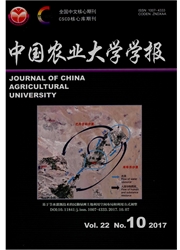

 中文摘要:
中文摘要:
利用小试装置模拟辽河口芦苇湿地,对不同浓度造纸废水灌溉条件下湿地土壤中锰形态分布特征及再分配过程进行分析,以期对湿地有效利用造纸废水提供指导。结果表明:1)湿地土壤中锰各形态含量为:残渣态(792.18mg/kg)、可还原态(259.38mg/kg)、弱酸态(103.26mg/kg)、可氧化态(26.82mg/kg),残渣态与可还原态是辽河口湿地土壤锰的主要赋存形态。灌溉造纸废水后,湿地土壤中弱酸态锰增大,可还原态锰、残渣态锰降低;随灌溉废水浓度增大,残渣态锰逐渐增加,可还原态锰逐渐降低,弱酸态锰与可氧化态锰含量基本不变;2)芦苇生长影响湿地土壤中锰的再分配:快速生长期锰再分配系数最大,锰各形态分布最不稳定,其次是成熟期;发芽期、展叶期和抽穗期锰再分配系数较小,锰各形态分布相对稳定。采用高浓度(CODCr浓度300mg/L)废水灌溉,对锰各形态再分配影响最大,低浓度(CODCr浓度50mg/L)废水对锰的形态再分配影响最小;3)灌溉造纸废水可降低湿地土壤中锰残渣态含量,减少湿地土壤中锰累积。
 英文摘要:
英文摘要:
To provide guidance for efficient usage of wastewater in reed wetland,the morphology distribution and redistribution of manganese in reed wetland irrigated by papermaking wastewater were analyzed by simulating Liaohe River estuary with experimental device schemes.The results indicated that:1)The contents of different forms of manganese in soil were residual fractions (792.18 mg/kg),reducible fractions (259.38 mg/kg),weak acid extractable fractions (103.26 mg/kg) and oxidizable fractions (26.82 mg/kg),respectively.Residual and reducible fractions were the main fractions in reed wetland.The content of weak acid extractable fractions increased,but the contents of reducible and residual fractions decreased after irrigation.With the increasing of CODCr concentration,the residual fractions increased gradually while the reducible fractions decreased,the weak acid extractable and oxidizable fractionskept stable;2)The redistribution of manganese in soil was dependent on the growing process of reed.The redistribution coefficient of manganese was the highest at rapid growth stage of reed,followed by mature stage.However,among the germination,leaf extension and heading stages of reed,the redistribution coefficient of manganese declined and manganese's morphology distribution was stable.The most influential effect of manganese redistribution in wetland soil occurred when the wetland was irrigated with 300 mg/L CODCr.Wastewater with 50 mg/L CODCr showed the least effect;3) Papermaking wastewater irrigation reduced the residual content of manganese in soil,which leaded to the decrease of manganese content in wetlands.
 同期刊论文项目
同期刊论文项目
 同项目期刊论文
同项目期刊论文
 期刊信息
期刊信息
